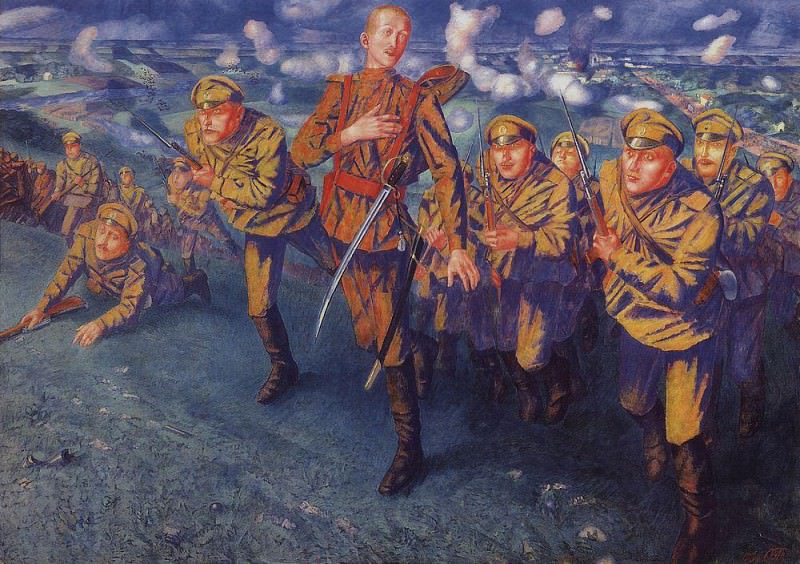On the line of fire. 1916 Kuzma Sergeevich Petrov-Vodkin (1878-1939)
Kuzma Sergeevich Petrov-Vodkin – On the line of fire. 1916
Edit attribution
Download full size: 1000×704 px (0,2 Mb)
Painter: Kuzma Sergeevich Petrov-Vodkin
Location: State Russian Museum, St. Petersburg (Государственный Русский Музей).
During wartime, the artist found himself serving in the military department in Petrograd. Therefore, what is military action, what is the life of officers and soldiers, he knows firsthand. In the painting "On the Line of Fire," Petrov-Vodkin uses a three-color color scheme. Namely blue, yellow and red colors. These are the tones in which he conveys the image of the Civil War. The movements of the military are smooth and slow.
Description of Kuzma Petrov Vodkin’s painting "In the Line of Fire
During wartime, the artist found himself serving in the military department in Petrograd. Therefore, what is military action, what is the life of officers and soldiers, he knows firsthand. In the painting "On the Line of Fire," Petrov-Vodkin uses a three-color color scheme. Namely blue, yellow and red colors. These are the tones in which he conveys the image of the Civil War.
The movements of the military are smooth and slow. And the compositional principle chosen by the artist allows us to consider the heroes from the side and from above. Petrov-Vodkin successfully conveyed the image of the Earth as a planet. Military as if they are climbing to a peak, but can not get up. And in general, this image is very tragic. The second title of this painting is "the first German war. The soldiers of the Russian army are dying with eyes full of horror and despair. Their task is to save, to protect the tsar and the fatherland. But they succeed in doing neither. The impression is that they are now also slowly falling one by one dead to the ground. And everyone will have that panic and that horror in their wide-open eyes.
The painting clearly expresses that tragic time when the country was literally falling apart before our eyes, but everyone firmly believed in a happy bright future. That’s just the author of the painting did not believe. And he portrayed the inability of people to rise to something higher. And the blue, airy dreams remain somewhere behind. The painting is a kind of symbol of an entire era when people believed in "castles in the air" and selflessly pursued unfulfilled dreams. Only at the end did they realize the meaninglessness of the situation.
Кому понравилось
Пожалуйста, подождите
На эту операцию может потребоваться несколько секунд.
Информация появится в новом окне,
если открытие новых окон не запрещено в настройках вашего браузера.
You need to login
Для работы с коллекциями – пожалуйста, войдите в аккаунт (open in new window).




















COMMENTS: 2 Ответы
Превосходно. И экспресивно, и убедительно, и лирично – индивидуальный мир не теряется в окружении других фигур. Писать можно о любом элементе живописи – композиции, цвете, стиле – все исполнено мастером!
1916 год. Первая мировая. Уже гибли солдаты и офицеры России за союзнические интересы. Кузьма любит обзор, панорамность. Наверное он хотел сказать. За Родину умирать это честно. А может хотел сказать. Да почто в дали от Родины русский погибать должен. Поди разбери. Но и офицеры и солдаты это всё наши християне наши люди наше добро, да втянулись в гиблое дело. Война завсегда толстосумам выгода а народу смута и разорение.
You cannot comment Why?
The background is a tumultuous scene with smoke plumes and what appear to be explosions, indicating active combat. The landscape is rendered with muted greens and browns, contrasting with the dramatic, dark blue and stormy sky above. The overall impression is one of urgency and danger, as the soldiers press forward into the chaos of battle.
The subtext of the painting is a powerful depiction of the human experience of war. The expressions on the soldiers faces, though somewhat stylized and not entirely clear, convey a sense of grim determination, fear, and perhaps a loss of individual identity in the face of overwhelming conflict. The central figure, with his hand on his chest and direct gaze, might represent leadership, courage, or even a premonition of death. The imagery strongly suggests the brutal realities of trench warfare and the relentless advance of troops into perilous situations, highlighting themes of sacrifice, bravery, and the destructive nature of conflict.